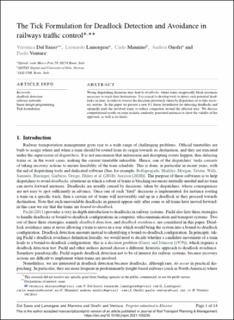| dc.contributor.author | Dal Sasso, Veronica | |
| dc.contributor.author | Lamorgese, Leonardo | |
| dc.contributor.author | Mannino, Carlo | |
| dc.contributor.author | Onofri, Andrea | |
| dc.contributor.author | Ventura, Paolo | |
| dc.date.accessioned | 2022-05-11T12:32:37Z | |
| dc.date.available | 2022-05-11T12:32:37Z | |
| dc.date.created | 2021-02-02T16:49:14Z | |
| dc.date.issued | 2021 | |
| dc.identifier.citation | Journal of Rail Transport Planning & Management. 2021, 17, 100239. | en_US |
| dc.identifier.issn | 2210-9706 | |
| dc.identifier.uri | https://hdl.handle.net/11250/2995283 | |
| dc.description.abstract | Wrong dispatching decisions may lead to deadlocks, where trains reciprocally block resources necessary to reach their destinations. It is crucial to develop tools to detect such potential deadlocks on time, in order to reverse the decisions previously taken by dispatchers or to take recovery actions. In this paper we present a new 0,1 linear formulation for detecting deadlocks and optimally park the involved trains to reduce congestion around the affected area. We discuss computational results on some realistic randomly generated instances to show the validity of the approach, as well as its limits. | en_US |
| dc.language.iso | eng | en_US |
| dc.publisher | Elsevier | en_US |
| dc.subject | Deadlock detection | en_US |
| dc.subject | Railways networks | en_US |
| dc.subject | Linear integer programming | en_US |
| dc.subject | Tick formulation | en_US |
| dc.title | The Tick Formulation for deadlock detection and avoidance in railways traffic control | en_US |
| dc.type | Peer reviewed | en_US |
| dc.type | Journal article | en_US |
| dc.description.version | acceptedVersion | en_US |
| dc.source.pagenumber | 12 | en_US |
| dc.source.volume | 17 | en_US |
| dc.source.journal | Journal of Rail Transport Planning & Management | en_US |
| dc.identifier.doi | 10.1016/j.jrtpm.2021.100239 | |
| dc.identifier.cristin | 1886018 | |
| dc.relation.project | Norges forskningsråd: 267554 | en_US |
| dc.relation.project | Norges forskningsråd: 237718 | en_US |
| dc.source.articlenumber | 100239 | en_US |
| cristin.ispublished | true | |
| cristin.fulltext | postprint | |
| cristin.qualitycode | 1 | |
